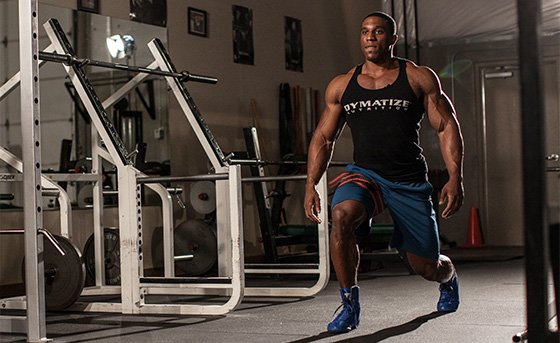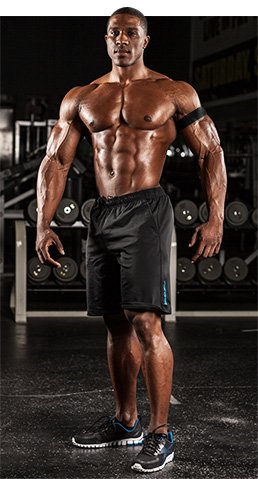Q. I keep hearing about occlusion training? It sounds bizarre. Is there anything to it?
Before I answer that question with a brief story, let me explain occlusion training for the uninitiated. Occlusion training, or what scientists call "blood flow restriction training" (BFR), involves restricting blood flow in the veins of a working muscle to elicit gains in size and strength. It sounds crazy, and there's definitely more to it, but that should get everyone on the same page.
Now, to my story: It was Christmas of 2008. My brother Gabe, the other Dr. Wilson, gave me a gift. I opened it and found a pair of knee wraps.
I asked: 'Gabe, why in the heck would you give me knee wraps, which I don't use?" He then explained that they were to restrict blood flow while I trained. It sounded strange, but I put my trust in my brother. Following his directions, I wrapped the knee wraps around my upper arms the next time I trained.
I had never felt a pump like that before! I mean, my arms swelled up like a balloon. I knew then that I had to dedicate serious lab research to this topic.
Since then, I've spent untold hours studying the ins and outs of occlusion training and helped to publish a number of peer-reviewed studies on the subject. Today, I can say confidently that BFR is a technique worth considering for anyone who wants to build muscular strength and size.
Of course, like anything, it only works if you do it right. Let's talk about the how and why.
How Does BFR Work?
In a sport where the majority of our time is spent figuring out how to increase blood flow, blocking it seems backward. How could that possibly that be beneficial? The short answer is that you should not completely restrict blood flow.[1] That's important to remember, so take a second to let it settle in.
Occlusion training involves wrapping a device like a pressure cuff or knee wraps around the top of a limb at a pressure sufficient to occlude, or obstruct, blood flow to the veins, but not the arteries.[2,3] This way, the arteries continue to deliver blood to the limb, and the blood pools in the limb as the veins struggle to take it back to the heart.
There are at least three ways that BFR works.[3, 5-7] You may have used the phrase "get my swole on" before—it's OK, we all have—but you'll really learn what it means once you apply a wrap. During BFR, muscle cells reach a point where they are so full of fluid that they have to either burst or grow.[6]
The second way BFR works is that the low oxygen level in a muscle during the accumulation of blood forces your body to recruit larger fast-twitch fibers, resulting in extreme growth.
Finally, when oxygen is low, lactic acid rapidly accumulates. This may sound bad, but studies show lactic acid by itself can increase protein synthesis![8]
How Do I Do It?
Recently Jeremy Loenneke and I published an extensive research paper on BFR in which we analyzed numerous BFR topics to determine what works best.[4] First, we compared BFR walking to BFR lifting at 20-40 percent of an individual's 1RM, and we found that lifting was more effective than walking.
However, we still recommend people use BFR walking when they are injured, or to get accustomed to the technique before progressing to lifting.[9] We also found that shorter rest periods of roughly 30 seconds optimize swelling and lactic acid accumulation in the muscle.

With occlusion training, you don't need much weight to reach fatigue. Your bodyweight is often enough.
More recently, Dr. Thiebaud conducted a study on the best contraction for BFR.[10] He compared concentric (the lifting portion) to the eccentric (lowering) portion of a lift. During traditional heavy lifting, the eccentric portion causes the most growth, but he found the opposite with BFR! The concentric part of lifting is most important. This suggests we should focus on pumping the reps out, while aiming to flood the muscle with fluid and lactate.
As for what device to use, well, most scientists use a training tool known as a KAATSU device, which costs more than $10,000. What bodybuilder is going to spend that kind of money? None I know. For this reason Loenneke, Ryan Lowery, and I recently conducted a series of studies on what we call "Practical BFR Training."[2,11]
With our method, you use knee wraps for the legs, and wrist wraps for the arms. We also found that, just like the KAATSU, practical BFR could drastically increase muscle cell swelling, muscle fiber recruitment, as well as blood lactic acid levels.[2]
Lowery, an elite scientist on the study of BFR, showed the efficacy of the method recently in an 8-week study in which he found that practical BFR could cause the same types of gains that were achieved with the KAATSU device.[11]
BFR Made Simple

"Pressure that lifters perceived to be a 7 on a scale of 10 on the legs, and 5-6 on the arms, reliably occluded the veins but not the arteries. This is as tight as you should go, and no tighter."
The problem, as you might expect, is that many lifters don't know how tightly to wrap to restrict the veins and not arteries. This is no good. But our study addressed the problem directly, and we found a simple approach to make sure you're on the right track.
Simply put, wrapping at a pressure that lifters perceived to be a 7 on a scale of 10 on the legs, and 5-6 on the arms, reliably occluded the veins but not the arteries. This is as tight as you should go, and no tighter.
You may have to do some tinkering to find your 7, but you should never wrap as tight as possible, which would be a 10.
As for weight, all the research indicates that there's no benefit to be gained from going heavy. Select a weight that is 20-40 percent of your 1RM—seriously! Trust me, it will feel much heavier by the end.
Our recommendation for the ideal BFR workout to optimizing growth is 4 sets with reps of 30, 15, 15, and 15, with only 30 seconds rest between sets. Perform this workout 2-3 times per week.
It is essential that you wrap directly around in a circular manner on a narrow area, such as the narrowest part of the upper arm. Wrapping in a wider area puts you at risk for occluding the arteries.[4]
Try this cutting-edge training technique and let me know what you discover!
References
- Kacin A, & Strazar K (2011). Frequent low-load ischemic resistance exercise to failure enhances muscle oxygen delivery and endurance capacity. Scand J Med Sci Sports, 21, e231-241.
- Wilson JM, Lowery RP, Joy JM, Loenneke JP, & Naimo MA (2013). Practical Blood Flow Restriction Training Increases Acute Determinants of Hypertrophy Without Increasing Indices of Muscle Damage. J Strength Cond Res, epub ahead of print.
- Loenneke JP, Abe T, Wilson JM, Ugrinowitsch C, & Bemben MG (2012) Blood flow restriction: how does it work? Front Physiol, 3, 392.
- Loenneke JP, Wilson JM, Marin PJ, Zourdos MC, & Bemben MG (2012). Low intensity blood flow restriction training: a meta-analysis. Eur J Appl Physiol, 112(5), 1849-1859.
- Loenneke JP, Fahs CA, Wilson JM, & Bemben MG (2011). Blood flow restriction: the metabolite/volume threshold theory. Med Hypotheses, 77(5), 748-752.
- Loenneke JP, Fahs CA, Rossow LM, Abe T, & Bemben MG (2011). The anabolic benefits of venous blood flow restriction training may be induced by muscle cell swelling. Med Hypotheses, 78(1) , 151-154.
- Loenneke JP, Wilson GJ, & Wilson JM (2010) A mechanistic approach to blood flow occlusion. Int J Sports Med, 31(1) , 1-4.
- Schoenfeld, BJ (2013). Potential mechanisms for a role of metabolic stress in hypertrophic adaptations to resistance training. Sports Med, 43(3), 179-194.
- Loenneke JP, Abe T, Wilson JM, Thiebaud RS, Fahs CA, Rossow LM, & Bemben MG (2012) Blood flow restriction: an evidence-based progressive model. Acta Physiol Hung, 99(3) , 235-250.
- Thiebaud RS, Yasuda T, Loenneke JP, Abe T (2013). Effects of low-intensity concentric and eccentric exercise combined with blood flow restriction on indices of exercise-induced muscle damage. Interven Med Appl Sci, 5, 53-59.
- Lowery RP, Joy JM, Loenneke JP, Oliveira de Souza E, Weiner S, McCleary S, & Wilson JM (2013). Practical blood flow restriction training increases muscle hypertrophy during a periodized resistance training program. National Strength and Conditioning Conference, J Strength Cond Res supplement.

